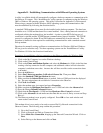Appendix H - GSM, SIM, PIN and the Observer Camera
The GSM cellular network (Global System for Mobile communications) is the most prevalent
cellular network in the world. In order to access this network with the Observer camera a SIM
(Subscriber Identity Module) card is required. This small plastic card is the same as used in
cellular phones. It contains the account information and stored phone numbers and text
messages. A properly provisioned SIM card must be inserted into the back of the camera before
any images can be transmitted.
The account contained on a SIM card may be provisioned for different network capabilities. For
instance, voice service is required to use a regular cell phone. The Observer camera requires a
SIM card provisioned for the ‘data pathway’ of the GSM network. This pathway, called GPRS
(General Packet Radio Service), allows the camera to transmit images to the Internet. A ‘voice
provisioned’ SIM is not required as the Observer has no voice communications capabilities. An
account with voice capabilities will not interfere with the Observer operations, it will simply
remain unused. Since each capability is an added expense the best option for the Observer
camera is a ‘data only’ SIM account. Additionally, text messaging (sometimes called SMS) may
be required if the text message notification capability or adjusting the Observer’s operation via
text messaging is desirable. Most service provides will simply charge a nominal fee (10 cents)
for each text message sent if that capability is not explicitly included in the service plan.
Expenses based on usage of the data portion of a cellular network will depend on the amount of
data sent by the camera. Most cellular providers will offer plans based on the usage of 10, 20 or
more millions of bytes (megabytes) per month. A typical outdoor, full resolution Observer image
with medium compression will require about 50-65 kilobytes (thousand bytes). Thus about 15-20
images can be transmitted per megabyte of usage. A limited plan may be the most inexpensive if
the camera is to transmit only about a hundred images each month. Plans allowing an unlimited
amount of data transmission each month may be the best value if the camera is to be used more
frequently.
SIM cards may require the use of a 4 to 8 digit personal account number (PIN). If a PIN is
required, this number will be included with the documentation received from the service provider.
This number must be entered into the correct field in the “System Settings” page during the
Observer configuration process. If no PIN is required this field may be left blank. Its important
to make sure that the correct number is entered here (if required). An incorrect number will
render the camera unable to transmit pictures. More importantly, if the camera tries three times in
a row to transmit an image using an incorrect PIN, the SIM card will become ‘locked’. This is an
anti-theft algorithm built into the SIM card. If the card becomes locked due to an incorrect PIN,
an unlock code or PUK code must be obtained from the original service provider. The SIM card
then must be inserted into a GSM cell phone and the unlock procedure completed. The Observer
camera has no capability to unlock a SIM card . If the unlock procedure is attempted 10 times in
a row with the incorrect PUK code the SIM card will become permanently locked. A new SIM
card must then be obtained.
To avoid this situation, enter the correct PIN in the Observer’s “System Settings” page. Go to the
“Test and Troubleshoot” page and run the Modem Configuration/Cellular Service test. If the
SIM requires a PIN and the incorrect PIN has been entered the test will fail and display a message
advising to check the PIN number. Go back to the “System Settings” page and enter the correct
PIN. Do not continue to repeat the test with the incorrect PIN number. The SIM card will
become locked after the third try.
43


















